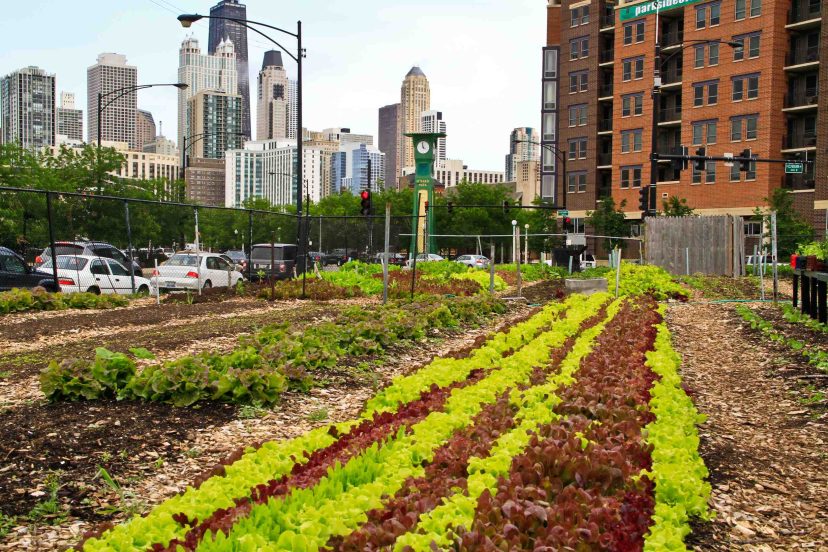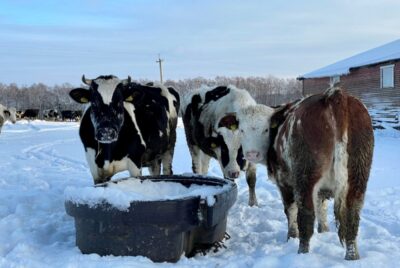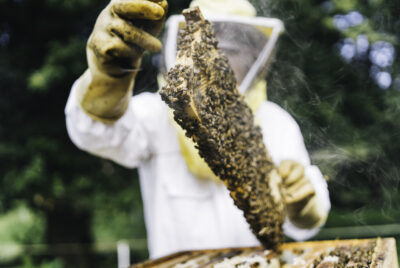Urban Homesteading: Embracing Sustainability and Self-Sufficiency In The City
"We may earn a commission from purchases made using our links. Please see disclaimer."
As an avid enthusiast and advisor on the subject of urban homesteading and homesteading in general, I am thrilled to share with you the wonders of creating your own sustainable oasis right in the city. Urban homesteading has become a popular lifestyle choice for individuals seeking a closer connection with nature, self-sufficiency, and a more sustainable way of living. In this article, I will provide you with helpful suggestions and reasons for embracing urban homesteading, along with practical tips to get started and overcome common challenges.
Benefits of Urban Homesteading
1. Sustainability and Self-Sufficiency
Urban homesteading allows you to reduce your ecological footprint and embrace a more sustainable lifestyle. By growing your own food, generating renewable energy, and implementing eco-friendly practices, you can significantly decrease your reliance on external resources.
Producing your own fruits, vegetables, and herbs reduces the need for transportation and packaging, contributing to a greener planet.
The practices of urban homesteading enable you to live a more self-sufficient life by meeting more of your family’s needs directly from your own land and labor. This reduces your reliance on mass production and long supply chains, which are less sustainable.
Urban homesteading leads to a more resilient localized model of providing for one’s needs. Urban homesteading gives you more control over and responsibility for your consumption.
2. Fresh and Nutritious Food
 One of the most rewarding aspects of urban homesteading is the ability to enjoy fresh, organic produce straight from your garden. By growing your own food, you have control over the cultivation methods, ensuring that your harvest is free from harmful pesticides and chemicals.
One of the most rewarding aspects of urban homesteading is the ability to enjoy fresh, organic produce straight from your garden. By growing your own food, you have control over the cultivation methods, ensuring that your harvest is free from harmful pesticides and chemicals.
The taste and nutritional value of homegrown vegetables and herbs are unparalleled, providing you and your family with a continuous supply of wholesome nourishment.
You can pick produce at its peak ripeness for maximum flavor and nutritional benefits. Homegrown food often contains higher levels of vitamins and antioxidants.
Additionally, you can grow rare, heirloom varieties that may be hard to find elsewhere. Homegrown food provides unmatched freshness and nourishment for better health.
3. Cost Savings and Financial Independence
Urban homesteading presents an opportunity to save money and achieve financial independence. By producing your own food, you can significantly reduce your grocery bills, especially during peak growing seasons.
Additionally, you can explore various methods of preserving and storing your harvest to enjoy the abundance throughout the year. The money saved can be allocated towards other important aspects of your life or invested in furthering your homesteading endeavors.
Homesteading reduces reliance on food from the store, allowing you to be less affected by food pricing and inflation. It also develops skills for greater self-sufficiency, making you less dependent on purchasing goods and services.
Homesteading promotes a frugal, DIY approach to meeting daily needs creatively from local resources. Overall, homesteading leads to reduced living costs and greater financial resilience.
4. Connection with Nature and Community
 Living in an urban environment provides limited opportunities to connect with nature. However, urban homesteading offers a way to bridge that gap and establish a deep bond with the natural world. Tending to plants, nurturing animals, and observing the cycles of life bring a sense of tranquility and fulfillment.
Living in an urban environment provides limited opportunities to connect with nature. However, urban homesteading offers a way to bridge that gap and establish a deep bond with the natural world. Tending to plants, nurturing animals, and observing the cycles of life bring a sense of tranquility and fulfillment.
Moreover, urban homesteading can foster a sense of community as like-minded individuals come together to share knowledge, resources, and experiences. Engaging in community gardens and farming, farmer’s markets, and workshops allow for meaningful connections and the exchange of ideas.
Working closely with the land reconnects you to nature’s rhythms and the origins of your sustenance. Caring for plants and animals cultivates a spirit of stewardship and appreciation for life. Sharing your bounty and skills with neighbors strengthens community bonds.
In general, homesteading enhances both ecological and social relationships.
Getting Started with Urban Homesteading
Now that you understand the numerous benefits of urban homesteading, let’s delve into the practical steps to get started on your journey toward self-sufficiency and sustainability.
Assessing Available Space
Evaluate the space you have available for your urban homestead. It could be a backyard, a balcony, or even a windowsill. Take measurements, consider sunlight exposure, and assess the possibilities for gardening, raising animals, and implementing sustainable practices.
Carefully survey all ground space, vertical space, and indoor and outdoor areas. Brainstorm creative ways to utilize awkward areas. Make illustrations and plans to map out potential layouts and placements. Thorough space planning is key for maximum productivity.
Container Gardening and Vertical Farming
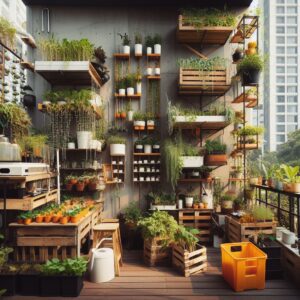 If you have limited space, container gardening is an excellent option. Choose suitable containers, such as pots, raised beds, or hanging baskets, and select crops that thrive in confined spaces.
If you have limited space, container gardening is an excellent option. Choose suitable containers, such as pots, raised beds, or hanging baskets, and select crops that thrive in confined spaces.
Additionally, explore vertical farming techniques like trellises, vertical planters, and wall-mounted containers to maximize your yield.
Research compact and dwarf crop varieties suited for containers. Use vertical structures and multilevel arrangements to optimize growth upwards. Be creative with vertical spaces both indoors and out.
Proper container gardening techniques allow bountiful harvests.
Composting and Recycling
Implementing composting and recycling systems is crucial for urban homesteaders. Composting kitchen scraps, yard waste, and other organic materials enriches the soil and reduces waste. Explore different composting methods, such as worm composting or bokashi composting, depending on your space and preferences.
Additionally, recycle diligently and find creative ways to repurpose items instead of sending them to a landfill.
Set up accessible systems that make composting and recycling easy habits. Learn what materials can be composted or recycled. Close the loop by returning nutrients to the soil.
Compost and recycling are cornerstones of the homesteading ethos.
Raising Backyard Chickens and Small Livestock
For those interested in animal husbandry, consider raising backyard chickens or small livestock. Chickens provide fresh eggs, help with pest control, and produce nutrient-rich compost through their droppings. Be sure to check local regulations, obtain necessary permits, and provide appropriate housing and care for your animals.
Research your city’s laws regarding urban livestock beforehand. Provide predator-proof coops and rotate grazing areas. Consider the time commitment involved in properly caring for animals. When done responsibly, small-scale urban livestock offers numerous benefits.
For more info from one of our trusted partners go read How To Start Urban Homesteading or Suburban Homesteading.
Growing Food in Urban Homesteading
Growing your own food is the heart of urban homesteading. Follow these suggestions to ensure a thriving urban garden:
1. Choosing the Right Crops and Varieties
 Select crops that are well-suited for your local climate, available space, and personal preferences. Consider fast-growing vegetables like lettuce, radishes, and herbs for quick harvests. Additionally, explore compact varieties bred specifically for small spaces, such as bush beans or dwarf fruit trees.
Select crops that are well-suited for your local climate, available space, and personal preferences. Consider fast-growing vegetables like lettuce, radishes, and herbs for quick harvests. Additionally, explore compact varieties bred specifically for small spaces, such as bush beans or dwarf fruit trees.
Talk to experienced gardeners nearby for their variety of recommendations. Test different crops each season to find out what works best. Favor hardy, high-yielding, space-saving plants. Careful crop selection makes urban gardening productive and rewarding.
2. Organic Gardening Practices
Maintaining organic practices is essential for the health of your garden and the environment. Avoid synthetic fertilizers and pesticides, opting for organic alternatives instead. Embrace natural pest control methods like companion planting, attracting beneficial insects, and using homemade organic sprays.
Build soil health through compost, mulch, and cover cropping. Handpick pests and use row covers or netting for protection. Organic methods nurture resilient plants naturally without toxins.
3. Utilizing Small Spaces Efficiently
Maximize your limited space by implementing space-saving techniques. Explore intercropping, where compatible plants are grown in close proximity, or succession planting, where new crops are sown as soon as others are harvested.
Additionally, consider vertical gardening, utilizing trellises, and employing intensive planting methods like square-foot gardening. Make use of windowsills and hanging baskets indoors too. Rethink wasted spaces and find ways to cultivate them. With creativity, small spaces can yield abundantly.
4. Seasonal Planting and Crop Rotation
 Plan your planting schedule according to the seasons and local climate. Rotate crops annually to prevent soil depletion and control pests and diseases. By diversifying your garden and embracing seasonality, you’ll enjoy a continuous harvest and maintain soil health.
Plan your planting schedule according to the seasons and local climate. Rotate crops annually to prevent soil depletion and control pests and diseases. By diversifying your garden and embracing seasonality, you’ll enjoy a continuous harvest and maintain soil health.
Note frost dates and plant timing for your area. Observe and record results to refine your seasonal schedule. Rotating crops replenishes and protects the soil. Planning your garden by season leads to sustained bounty.
Sustainable Living Practices
Beyond food production, urban homesteading encompasses various sustainable living practices. Here are some areas to focus on:
1. Rainwater Harvesting and Water Conservation
Collect rainwater using barrels or other suitable containers. Use this harvested water for watering your plants, reducing the reliance on municipal water sources.
Additionally, practice water conservation techniques such as using drip irrigation, mulching, and watering during cooler times of the day to minimize water waste.
Install a rain catchment system with proper screens and covers. Use soaker hoses, timers, and moisture sensors for efficient irrigation. Reuse gray water from the home where possible. Conserving water resources ensures their long-term sustainability.
2. Energy-Efficient Strategies
 Implement energy-saving measures in your urban homestead. Use energy-efficient appliances and LED lighting. Harness natural light by strategically placing windows and skylights. Consider utilizing solar panels to generate renewable energy for your home and garden. These practices not only reduce your environmental impact but also help save on utility bills.
Implement energy-saving measures in your urban homestead. Use energy-efficient appliances and LED lighting. Harness natural light by strategically placing windows and skylights. Consider utilizing solar panels to generate renewable energy for your home and garden. These practices not only reduce your environmental impact but also help save on utility bills.
Upgrade insulation, caulk drafts, and maintain heating and cooling units. Adjust thermostats and turn off unused lights. Transition to clean energy sources over time. Energy efficiency reduces waste and saves money.
3. Reducing Waste and Recycling
Adopt a low-waste lifestyle by minimizing packaging, reusing items, and recycling diligently. Set up a recycling station in your home with separate bins for different materials.
Explore creative ways to upcycle items, turning them into useful and decorative objects. By reducing waste, you contribute to a healthier planet and inspire others to do the same.
Refuse unnecessary purchases and single-use items. Seek products with recycled content and minimal packaging. Reuse bottles, jars, and containers. Reducing waste starts with mindful consumption habits.
4. DIY Projects and Upcycling
Embrace the spirit of self-sufficiency by engaging in DIY projects and upcycling. Repurpose old furniture, containers, and materials to create functional and beautiful additions to your homestead. From building raised beds to constructing chicken coops, DIY projects not only save money but also provide a sense of fulfillment and pride.
Learn basic repair and building skills to maintain your homestead. Share your creations to motivate others. DIY and upcycling keep resources in use and build self-reliance.
Challenges and Solutions
While urban homesteading offers countless rewards, it also comes with its fair share of challenges. Here are some common obstacles and practical solutions to overcome them:
1. Limited Space and Resources
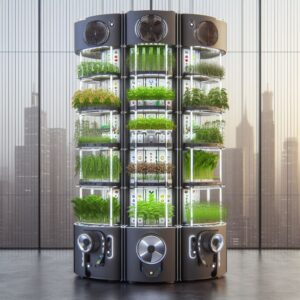 Make the most of your available space by utilizing vertical gardening, container gardening, and maximizing efficiency. Focus on high-yield crops and prioritize your needs and preferences. Additionally, seek community gardens or consider collaborating with neighbors to share resources and space.
Make the most of your available space by utilizing vertical gardening, container gardening, and maximizing efficiency. Focus on high-yield crops and prioritize your needs and preferences. Additionally, seek community gardens or consider collaborating with neighbors to share resources and space.
Rent garden plots to expand your growing area inexpensively. Trade goods and services to obtain needed supplies. With flexibility and cooperation, available resources can be optimized.
2. Urban Regulations and Zoning
Be aware of local regulations regarding urban homesteading, including rules for keeping chickens, beehives, and composting. Obtain any necessary permits and follow the guidelines to ensure compliance. Engage with local authorities and advocate for more lenient regulations that support sustainable living.
Submit well-researched proposals for codes that facilitate homesteading appropriately. Build relationships with officials and demonstrate responsible practices. Progress happens gradually through reasonable reforms.
3. Community Involvement and Collaboration
Urban homesteading thrives in a supportive community. Engage with like-minded individuals through local gardening groups, online forums, and workshops. Share knowledge, resources, and surplus produce.
By collaborating and supporting each other, you create a strong network that fosters growth and resilience.
Volunteer at community gardens to give back. Host gatherings to meet potential mentors and partners. Spread awareness of your cause. Building community multiplies the impact of your efforts.
4. Creative Solutions for Common Obstacles
In the face of limited space, explore alternative gardening methods such as hydroponics or aquaponics. Utilize small nooks and crannies for vertical gardens or install a rooftop garden.
Get creative with storage solutions for tools and supplies, using vertical racks or repurposed furniture. Embrace innovative ideas and think outside the box to overcome challenges.
Seek unconventional solutions and be willing to experiment. Obstacles provide opportunities for ingenuity and resourcefulness.
Incorporating Animals in Urban Homesteading
While traditional homesteading often includes larger livestock, urban homesteading can still accommodate animals on a smaller scale. Consider the following:
1. Benefits of Backyard Chickens and Bees
 Backyard chickens provide fresh eggs, natural pest control, and soil enrichment through their droppings. Bees play a crucial role in pollination, benefiting your garden and the local ecosystem.
Backyard chickens provide fresh eggs, natural pest control, and soil enrichment through their droppings. Bees play a crucial role in pollination, benefiting your garden and the local ecosystem.
By keeping bees, you also contribute to the preservation of these vital pollinators.
Chickens and bees both produce food while enhancing the sustainability of your homestead. The essential services they provide far outweigh the modest resources they require. They are ideal introductory urban livestock.
2. Caring for Urban Livestock Responsibly
Before getting animals, research their specific needs and ensure you can provide adequate care and space. Consider the temperament, size, and noise levels of the animals you choose. Consult local regulations regarding urban livestock and provide proper shelter, food, and veterinary care.
Give animals sufficient indoor and outdoor access. Keep coops clean, dry, and well-ventilated. Provide fresh food, water, and enrichment activities. Meeting animals’ fundamental needs demonstrates responsible urban husbandry.
3. Ensuring Animal Welfare and Neighborly Harmony
Maintain a clean and odor-free environment for your animals. Communicate with your neighbors, addressing any concerns they may have and ensuring that your urban homestead activities do not disrupt their daily lives.
Be a responsible pet owner and prioritize the well-being of your animals while also fostering positive relationships with those around you.
Properly containing and supervising animals prevents nuisance issues. Share benefits like fresh eggs to gain neighborhood support. Responsible urban livestock keeping maintains healthy communities.
Engaging the Community
Urban homesteading is not just about personal sustainability; it’s also about building connections and engaging with the community. Here’s how you can actively participate:
1. Sharing Surplus Produce and Resources
 As your urban homestead flourishes, you may find yourself with an abundance of fresh produce. Share your harvest with neighbors, friends, and local food banks.
As your urban homestead flourishes, you may find yourself with an abundance of fresh produce. Share your harvest with neighbors, friends, and local food banks.
Consider setting up a produce stand or participating in community food-sharing programs. Sharing not only fosters community bonds but also reduces food waste.
Trading goods strengthens relationships through mutual benefit and goodwill. Generosity should flow both ways in a healthy community.
2. Hosting Workshops and Educational Events
Share your knowledge and skills with others by hosting workshops and educational events. Teach gardening techniques, composting methods, or DIY projects.
By empowering others to embrace sustainable practices, you contribute to a greener and more self-sufficient community.
Make classes hands-on and interactive. Offer a free lending library. Lead by example in your daily habits. Education cultivates positive change one mind at a time.
3. Participating in Community Gardens and Farmer’s Markets
Join local community gardens or start one in your neighborhood. Collaborate with fellow urban homesteaders, exchange tips, and cultivate a sense of camaraderie.
Participate in farmer’s markets, showcasing your homegrown produce and connecting with local consumers who appreciate sustainable and locally sourced goods.
Volunteer for gardening work days. Organize social events. Consistent participation deepens a sense of community ownership.
4. Building a Network of Like-Minded Individuals
 Connect with like-minded individuals through social media groups, online forums, or local homesteading associations. Share experiences, seek advice, and learn from each other’s successes and challenges.
Connect with like-minded individuals through social media groups, online forums, or local homesteading associations. Share experiences, seek advice, and learn from each other’s successes and challenges.
Building a supportive network strengthens your own urban homesteading journey and contributes to the larger movement.
Mentor newcomers to pass on your knowledge. Organize mutual aid efforts. A rising tide lifts all boats – your network’s growth aids your own.
Balancing Work and Urban Homesteading
Finding a balance between work or other responsibilities and urban homesteading may seem challenging, but it’s achievable with careful planning and prioritization.
Time Management and Prioritization
Create a schedule that accommodates your work commitments while allowing time for tending to your urban homestead. Prioritize tasks based on their urgency and allocate specific time slots for activities such as gardening, animal care, and maintenance.
Efficient time management ensures that you can enjoy the benefits of urban homesteading without compromising other aspects of your life.
Keep a detailed calendar to stay on top of seasonal homesteading tasks. Group related tasks to maximize work sessions. Identify time-consuming tasks to minimize. Thoughtful scheduling integrates homesteading seamlessly.
Incorporating Homesteading Activities into Daily Routines
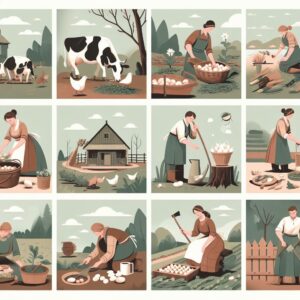 Integrate urban homesteading activities into your daily routines. Water your plants while enjoying your morning coffee, tend to your animals during your lunch break, and harvest produce in the evenings. By seamlessly incorporating these activities into your daily life, you optimize your time and fully enjoy the rewards of urban homesteading.
Integrate urban homesteading activities into your daily routines. Water your plants while enjoying your morning coffee, tend to your animals during your lunch break, and harvest produce in the evenings. By seamlessly incorporating these activities into your daily life, you optimize your time and fully enjoy the rewards of urban homesteading.
Schedule brief periods of overlapping activity during your normal routines. Assign homesteading duties to household members. Make tasks enjoyable habits, not chores. Weaving homesteading throughout your day makes it effortless.
The Therapeutic Aspect of Urban Homesteading
Embrace the therapeutic nature of urban homesteading. Engaging in activities like gardening, interacting with animals, and reconnecting with nature provides a sense of relaxation and fulfillment.
Make time to unwind and enjoy the serenity that comes with nurturing your urban homestead.
Savor the quiet moments observing your plants and animals. Try grounding techniques while working with soil. Make homesteading a meditative escape from daily stress. The healing benefits of homesteading enhance overall well-being.
Conclusion
Embarking on the journey of urban homesteading is a transformative experience that empowers individuals to embrace sustainability, self-sufficiency, and a deeper connection with nature. By following the suggestions and advice shared in this article, you can create your own thriving urban homestead, producing fresh food, reducing your environmental impact, and fostering a sense of community.
Urban homesteading is not just a lifestyle; it’s a movement towards a greener, more resilient, and fulfilling way of living.
Approach homesteading with an openness to continuous learning. Start small and let your skills and capacities grow over time. Join forces with like-minded people to magnify your impact. With intention and perseverance, urban homesteading creates ripples of positive change.
FAQs
1. Can I practice urban homesteading if I live in an apartment?
Absolutely! Even in limited spaces like apartments, you can engage in container gardening, grow herbs on your windowsill, and compost kitchen scraps using vermicomposting.
**2. Is urban homesteading only for people with extensive gardening knowledge?
Not at all! Urban homesteading is for everyone, regardless of their gardening knowledge. It’s a journey of learning and experimentation. Start small with easy-to-grow crops like herbs or salad greens, and gradually expand your knowledge and skills.
3. What if I don’t have access to outdoor space?
Lack of outdoor space doesn’t have to be a barrier to urban homesteading. You can explore indoor gardening techniques such as hydroponics or aquaponics, grow sprouts and microgreens on your kitchen counter, or join a community garden nearby.
4. How can I deal with pests and diseases in an organic way?
Organic pest control methods include companion planting, using natural insect repellents like neem oil or garlic spray, attracting beneficial insects, and maintaining healthy soil. Proper plant spacing, good airflow, and regular observation help prevent and manage diseases.
5. Can I make a significant impact on my ecological footprint through urban homesteading?
Absolutely! Every step you take towards sustainable living, such as growing your own food, reducing waste, conserving water, and using renewable energy, contributes to a significant reduction in your ecological footprint. Small actions collectively create a substantial impact.
6. How do I balance urban homesteading with a busy lifestyle?
Finding balance is key. Start with manageable tasks and gradually increase your involvement. Incorporate homesteading activities into your daily routines, delegate tasks when possible, and involve family members or neighbors in the process. Remember that urban homesteading is a journey, and progress is more important than perfection.
Embark on your urban homesteading journey with passion, curiosity, and a willingness to learn. Embrace the challenges as opportunities for growth, and relish in the rewards of self-sufficiency, sustainability, and connection with nature. Together, let’s create a greener, more resilient future right in the heart of our cities. Happy homesteading!

